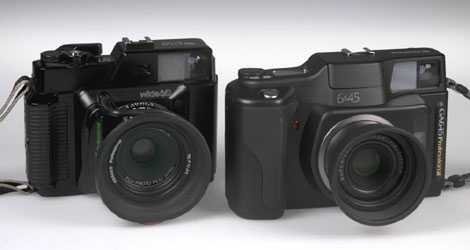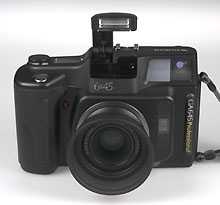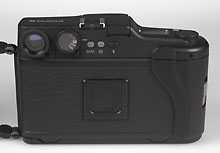
 When the Fuji GA645 was launched, I felt a bit peeved to be way down the
queue for looking at one. I've championed the cause of rollfilm
rangefinders since before they were remotely as popular as they are
today Ð ten years ago I tested every available Fujica (6 x 9cm, 6 x 7cm
and 6 x 4.5cm) against both Plaubel Makinas and their ProShift, and they
are cameras I have repeatedly returned to promote.
When the Fuji GA645 was launched, I felt a bit peeved to be way down the
queue for looking at one. I've championed the cause of rollfilm
rangefinders since before they were remotely as popular as they are
today Ð ten years ago I tested every available Fujica (6 x 9cm, 6 x 7cm
and 6 x 4.5cm) against both Plaubel Makinas and their ProShift, and they
are cameras I have repeatedly returned to promote.
I even own and use them - from a Brooks Veriwide (6 x 9cm, 47mm Super Angulon) in the 1970s to a Superwide C, a Plaubel Makina 67W, a Fuji GS645SW with 45mm lens, and finally my current travelling companion, the Fuji GS645S with its general purpose 60mm lens and CRF.
Why do I use this camera? Easy - it is as light and portable as any 35mm SLR, very fast to use, shoots 15 or 30 pictures per reload, is unobtrusive in appearance and sound, has built-in metering, and provides pictures of top quality which make my occasional submissions to picture libraries profitable.
It is also very rugged, bounces off concrete, and cost almost nothing - half the price of a used Hasselblad lens of the same focal length. If the metering battery fails the camera continues to function in all other respects.
The GS645SW is often the only camera I carry with me when abroad or out and about in town or country. It is an convenient as a 35mm compact, and the simple manual control aided by the CRF and spot metering is reliable. It's been the photographic equivalent of a short wheelbase lightweight Land Rover.

The replacement for this utility camera contrives, in price as well as features, to be a Nissan Terrano II turbo with an automatic gearbox. The GA645 Professional costs well into four figures, has a similar (not identical) 60mm Ä4 lens, and combines autofocus and programmed auto exposure with a built-in flash, motorised auto film loading and winding, and the usual overrides and manual modes.
I have now tried it, briefly, but not in conditions which compare it properly. I would need to take it away on a trip abroad and put twenty or more rolls of film through it, as I do with the old manual model, to see how well it really performs.
 It is much bigger than the GS645S, though slimmer for coat-pocketability.
The viewfinder is almost identically good and handling is excellent. The
program mode worked fine, and the auto wind (no need to line up arrows!)
and motor wind reduced down-time to a minimum. The AF was not as
predictably good and failed on some close shots, whereas the rangefinder
model has always been great for this - you just set minimum distance, and
focus by approaching the subject until the images coincide.
It is much bigger than the GS645S, though slimmer for coat-pocketability.
The viewfinder is almost identically good and handling is excellent. The
program mode worked fine, and the auto wind (no need to line up arrows!)
and motor wind reduced down-time to a minimum. The AF was not as
predictably good and failed on some close shots, whereas the rangefinder
model has always been great for this - you just set minimum distance, and
focus by approaching the subject until the images coincide.
There was absolutely no difference between shots on the old camera and the new one. In exposure, colour, contrast, exact lens angle and all aspects they could not be told apart.
As far as I can see, this AF version is not aimed at my kind of location, travel and stock photo use. It needs a couple of hard-to-find lithium cells, and I'm happy using the old model. I think the market lies in wedding photography, as a candid camera and for group shots with auto fill-in flash, or quiet work in church. Here, the AF, mini flash, fast loading and auto everything really count.
I'll follow up this introduction with opinions on its merits when we have have a chance to test it in genuine working situations like this. In the meantime, can someone explain why the secondhand columns of AP are always full of Fuji rollfilm rangefinders? Am I the only photographer to find them indispensible?
David Kilpatrick